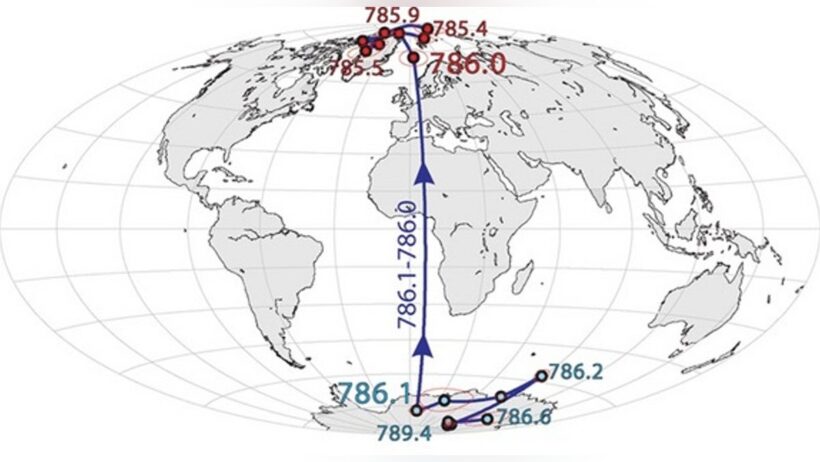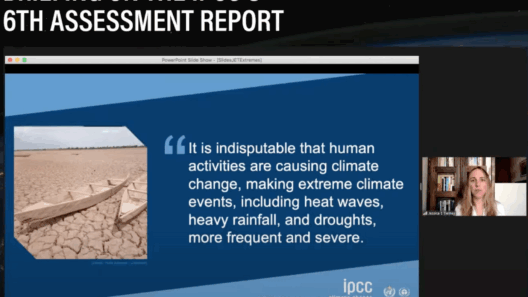The Earth’s magnetic field, a colossal force of nature, is akin to an invisible shield, safeguarding our planet and its inhabitants from solar radiation and cosmic particles. It is generated by the movement of molten iron in the outer core, giving rise to geomagnetic phenomena that have fascinated scientists for centuries. Yet, this magnetic guardian is not static; it exhibits fluctuations over time, including complete reversals, in which magnetic north and south switch places. This phenomenon, known as geomagnetic reversal, has occurred multiple times throughout Earth’s history, but what implications does it hold for contemporary climate systems?
To understand the potential impacts of a geomagnetic flip on climate, one must first appreciate the underlying mechanics of the Earth’s magnetic field. Picture the magnetic field as a vast expanse of dynamic waves, constantly shifting and evolving. This field not only shapes compasses but also deflects harmful solar winds, creating a buffer between life on Earth and the malevolent forces of the cosmos. However, during the transitional phase of a magnetic reversal, this protective barrier could weaken, leading to a variety of environmental changes.
The historical record reveals that geomagnetic reversals occur at irregular intervals—averaging about every 200,000 to 300,000 years. Notably, the last significant magnetic reversal, the Brunhes-Matuyama reversal, transpired approximately 780,000 years ago. Studying ancient climates through ice cores and sediment layers offers tantalizing glimpses into the Earth’s past. These geological archives reveal that during previous magnetic flips, climatic conditions did not exhibit significant dramatic shifts—at least not immediately. Average global temperatures remained relatively stable, which can be somewhat reassuring in the face of ongoing climate change discussions.
Nevertheless, it’s crucial to consider that the Earth’s climate system is a complex web of interdependencies, influenced by numerous factors beyond the magnetic field alone. Elements such as greenhouse gas concentrations, ocean currents, and solar output all intertwine to shape climatic conditions. The intricate interactions of these systems present challenges when attempting to isolate the effects of a magnetic reversal. What if the weakening of the magnetic field enhances cosmic ray influx, thereby influencing cloud formation and atmospheric chemistry? Such scenarios remain uncertain.
Furthermore, geomagnetic reversals are not swift; they may take thousands of years to complete. This gradual transition could provide the Earth with a cushion to adjust. Historical data suggests that life has persisted during such events, indicating a resilience in ecological systems. However, the apprehension stems from modern anthropogenic forces exacerbating natural processes. Today, we live in an era characterized by rapid climate change, driven predominantly by human activities such as fossil fuel combustion and deforestation.
The interplay between a possible future reversal and existing climate trends urges a deep contemplation. For instance, prolonged periods of reduced magnetic shielding could increase exposure to solar and cosmic radiation. Such exposure may have implications for satellite operations, technological systems, and even human health due to heightened radiation levels. Fluctuating radiation levels could lead to shifts in atmospheric dynamics, potentially influencing weather patterns and storm intensity. Moreover, the biota—the various forms of life on Earth—could be subjected to increased mutation rates, thereby impacting biodiversity.
To draw an analogy, envision Earth as a ship navigating turbulent seas. The magnetic field acts as a stabilizing force, ensuring safe passage through storms. A reversal could be likened to the ship turning sideways to the waves, exposing it to greater risk. While the vessel may withstand the initial shock of nature’s fury, the cumulative effects of turbulence over time could weaken its structure. Similarly, the effects of a geomagnetic reversal amidst the ongoing climatic upheaval could compound existing vulnerabilities.
Research on the impacts of geomagnetic reversals has been inconclusive, illustrating the need for continued inquiry into this enigmatic aspect of planetary science. Scientists explore correlation patterns between past reversals and major extinction events or climactic shifts through interdisciplinary methodologies, employing paleoclimatology, geology, and astrophysics to paint a comprehensive picture of Earth’s tumultuous history.
While climate change looms as a pressing challenge of our time, one must not overlook the multifaceted threats stemming from geomagnetic fluctuations. The future of Earth’s magnetic field remains uncertain, with its implications spanning environmental, technological, and health-related domains. An informed discourse can foster deeper understanding and preparedness for these phenomena, emphasizing the urgency to mitigate climate change proactively.
In summary, while the prospect of a geomagnetic reversal may not signal an immediate climatic catastrophe, it embodies a signal of caution. The resilient fabric of life on Earth is intricately woven, and any disruption within our planetary systems could bring about unforeseen consequences. Continuing to monitor geomagnetic activity and its interplay with the climate will be essential for navigating the challenges ahead. Building resilience, fostering adaptation, and reducing the anthropogenic pressures forming the backdrop of our current climatic crisis will ultimately be vital as we expand our comprehension of this dynamic planet we call home.








